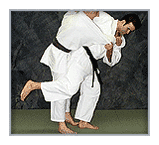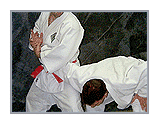Modern Judô is commonly called a sport (Olympic level since 1964), a martial art, a way of spiritual harmony, a system of physical education, and a recreational activity. To some extent, all these definitions are accurate. People who practice Judô completely dedicated to the art consider it a way of life, but a full appreciation of the true nature of Judô is yet to be attained by many of its exponents. This is because the scope of Judô has frequently been viewed too narrowly; many of its important cultural aspects have been played down in favor of a few specialized ones.
 In Japan, after the end of the bakufu (feudal government 1868), the Emperor was restored to power and an era of change swept Japan. The arts and skills of the samurai were a part of a heritage considered fossilic and outdated often falling into disuse.
In Japan, after the end of the bakufu (feudal government 1868), the Emperor was restored to power and an era of change swept Japan. The arts and skills of the samurai were a part of a heritage considered fossilic and outdated often falling into disuse.
Dr. Jigoro Kano, a schoolteacher and jujutsu expert, was determined to see the Japanese martial traditions enter the 20th century. His efforts brought together of many feudal jujutsu masters in an attempt to merge them into a modern scientific and educational system in line with the societal changes of the day. He called his system Kodôkan Judô, or “the gentle way”.
The syllabus of Judô can be broken down into four categories: Nage-waza (throwing techniques), Ne-waza (or Katame-waza – mat / grappling techniques), Kime-waza (self-defense) and Kata (two person forms).
Judô is centered upon the concept of “ju”, loosely translated as “gentleness”. In other words, when attacked, the Judôka (Judô practitioner) learns to relax making best use of his energy thus allowing to “give way” to the force of the aggressor. This principle, often described as “maximum efficiency with minimum effort”, is fundamental in understanding the art and way of Judô.
Here at Yama-ji, Judô is taught as a budô (martial art practiced as a way of life). All aspects of Judô are conveyed as established in the original three-fold path for Judô: body, character, and intellect.



 In Japan, after the end of the bakufu (feudal government 1868), the Emperor was restored to power and an era of change swept Japan. The arts and skills of the samurai were a part of a heritage considered fossilic and outdated often falling into disuse.
In Japan, after the end of the bakufu (feudal government 1868), the Emperor was restored to power and an era of change swept Japan. The arts and skills of the samurai were a part of a heritage considered fossilic and outdated often falling into disuse. At Yama-ji, Nihon-ryû Jujutsu is a complimentary martial art to Seibukan based Judô and Karate. Nihon-ryû is a modern jujutsu system focusing on close quarter combat.
At Yama-ji, Nihon-ryû Jujutsu is a complimentary martial art to Seibukan based Judô and Karate. Nihon-ryû is a modern jujutsu system focusing on close quarter combat.